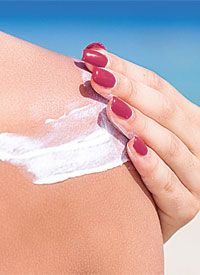Survivors of Non-Melanoma Skin Cancer Should Not Rely on Sunscreen Alone
The authors recommended that those who have experienced NMSC should rely more on sun avoidance and shade to protect their skin from UV rays. Adding sunscreen to those measures for a multi-modality strategy is “a highly beneficial approach,” they added.

Though people with a history of non-melanoma skin cancer (NMSC) often practice better sun protection than those without previous NMSC, they are not more successful in avoiding sunburn. According to a study recently published in the Journal of the American Academy of Dermatology, this points up a gap in the protection that sunscreen provides.
Survivors of NMSC face a higher risk of recurrence, or of developing melanoma. The easiest way to avoid such diagnoses is to decrease exposure to ultraviolet (UV) radiation and sunburn. Therefore, it is recommended that those with a history of NMSC—as well as the population at large—practice sun protection. However, evidence from the study suggests that sunscreen, upon which many participants relied, was not associated with fewer sunburns, either because it wasn’t applied properly or because it may have been inadequate when used alone as a sun-protection measure.
The authors recommended that those who have experienced NMSC should rely more on sun avoidance and shade to protect their skin from UV rays. Adding sunscreen to those measures for a multimodal strategy is “a highly beneficial approach,” they added.
The study retrospectively gathered responses from a group of 34,919 non-Hispanic whites, the population most greatly affected by NMSC; 758 of them had experienced NMSC. Data on the participants came from the National Health Interview Survey, for which they had answered questions about their sun-protection techniques and outcomes.
Participants in the study were first assessed on their sensitivity to the sun as well as their quantifiable exposure to the sun, which was found by asking for their body mass index (BMI) and the amount of physical activity they did per week.
They then evaluated themselves based on how frequently they employed certain sun protection techniques, which were staying in the shade, wearing a hat that shaded the face, ears and neck, wearing a long-sleeved shirt, and using sunscreen. Participants also reported whether they had been sunburned within the last 12 months.
Individuals with history of NMSC got sunburned less often than those with no history of NMSC (29.7% vs 40.7%) due to their greater use of sun-blocking techniques: use of shade (44.3 vs 27.0%), long sleeves (20.5% vs 7.7%), a wide-brimmed hat (26.1% vs 10.5%), sunscreen (53.7 vs 33.1%), and use of multiple methods (44.7% vs. 19.4%). Additionally, more people with previous NMSC reported avoidance of the sun altogether (12.8% vs 7.3%).
Although those numbers indicate differences in sunburn frequency between people with previous NMSC and people without, they are not statistically significant when the population of individuals who have had NMSC is analyzed according to age group. Younger members of this population are the most likely to get sunburned, and while those who are older use sun protection measures more successfully, they gain less relative benefit because their expected longevity is shorter.
“The crude percentage difference in sunburn between those with and without previous NMSC disappeared after stratification by age,” the authors wrote. “Approximately two-thirds (66.9%) of individuals aged 18 to 39 years with previous NMSC reported recent sunburn.”
Ultimately, people’s choice of sun protection methods seems to affect their sunburn frequency, the authors wrote. Among people who have experienced NMSC, sunscreen was more likely to be used by younger people, while their older counterparts were more likely to wear protective clothing and avoid the sun.
Although sunscreen was the most popular form of photoprotection among those in the study, it was not associated with avoidance of sunburns. This may be because people are not applying it correctly, putting on a layer that is too thin, or missing some parts of the skin. Additionally, the authors wrote, “intermittent sunscreen use may result in skin that is not as hardened from chronic UV exposure and more susceptible to acute episodes of sun exposure resulting in sunburn.” They found that the most effective ways to avoid sunburn are to seek shade and avoid the sun altogether.
“Physicians should thus continue to emphasize the importance of sunburn prevention, especially among younger individuals with previous NMSC,” the authors wrote. “Sun avoidance (including shade) may be a more effective means of photoprotection than use of sunscreen in those with previous NMSC, and should thus be emphasized when counseling patients. However, because of the commonness of sunscreen use, counseling efforts on ways to improve sunscreen effectiveness could also have a large public health impact in preventing sunburn.”
Cemiplimab as Adjuvant Therapy Improves DFS in High-Risk Cutaneous Squamous Cell Carcinoma
January 20th 2025Adjuvant cemiplimab demonstrated a statistically significant improvement in DFS compared to placebo in post-surgical patients with high-risk CSCC, impacting post-operative care considerations.


